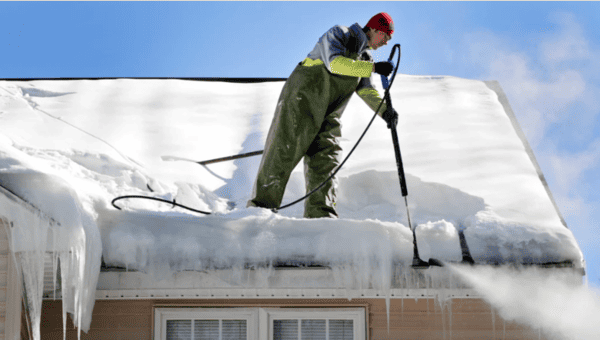Flowers don’t grow when winter approaches, but this doesn’t mean your revenue growth should slow. There are plenty of different jobs, trades, and gigs available for small business owners and entrepreneurs alike to consider in the colder seasons. To help you win customers and earn profits this upcoming winter, consider this list of 10 winter business ideas.
Seasonal Services for Winter Weather
For many places in the US and beyond, the winter season means winter weather. Cold weather can bring many conditions, including ice, snow, and sleet. Fortunately, this can also bring new service opportunities for entrepreneurs.
1. Gutter Cleaning
Gutter cleaning is an important part of winter maintenance for residential buildings and business properties. Proper gutter cleaning can keep ice dams from forming and prevent expensive issues like roof damage and leaks. For this reason, many entrepreneurs perform gutter cleaning services in the colder months.
To start, you’ll need the right equipment, such as gloves, scrapers, ladders, ladder stabilizers, tarps, trowels, and buckets. Additionally, you’ll need a vehicle to transport yourself and your equipment to different client locations. If you’re not afraid of getting your hands dirty, gutter cleaning can be a lucrative seasonal side hustle.
Startup Costs
A gutter cleaning business will require transportation, equipment, and may call for additional business expenses like liability insurance. Startup costs can range based on business location and service quality. Initial costs can range from $1,500 to $3,000, depending on your preferred equipment.
Potential Income
According to Indeed, the average income of gutter cleaners is $23 per hour.
2. Firewood Sales/Delivery
Winter is a popular season for firewood suppliers and delivery services, and if you can perform one or both of these roles, you’ll have plenty of extra income to keep you warm this upcoming season.
Now, this service won’t necessarily require you to find your own wood to sell. You can easily form agreements with local loggers to bring you wood that you can then split yourself or hire workers to split for you. From then, you can distribute wood to customers and businesses in your area.

Firewood must be properly stacked to dry before it can be burned in home fireplaces. (Source: Vermont Good Wood)
To drive the most profit, start early in the year. Wood must dry for several weeks or even months before it is ready for use in home fireplaces. If you have the space to stack wood to dry and the time to get started several months in advance, you can dry green wood to sell, which will cost much less than buying pre-dried wood from a larger firewood operation and to resell.
Alternatively, you can focus on selling green wood to other wood services or provide stacking services once the wood is delivered.
Startup Costs
Startup costs will depend on the size of your operations. These may include the direct costs of the firewood, inventory storage, and additional handling expenses, such as labor and equipment costs. Delivery services will also incur expenses for equipment maintenance, labor, and delivery vehicles.
Potential Income
Firewood jobs pay an average of $26.22 an hour according to Zippia.
3. Building Winterization
As homeowners and businesses prepare for the winter season, they must prepare their buildings for the harsh conditions of the cold weather. Weatherstripping, insulation, window sealing, and other protective measures help keep buildings warm and dry, and many customers will pay yearly for these services. This is especially true if the owner leaves their buildings unoccupied during winter, as is often the case with summer homeowners.
Another great aspect of this business is that you can provide a de-winterization service for that same client base once the weather begins to warm.
Startup Costs
Startup costs for this business may include a variety of equipment depending on the services offered. Additionally, you may wish to gain certifications for training on HVAC maintenance.
Potential Income
The income you can make from this weatherproofing depends on your business location, the size of the properties you service, and the types of services you provide. According to data from Angi, the cost to winterize a house is $250 on average but can cost between $65 and $1,000 or more depending on the extent of work required. Commercial building winterization can be even more lucrative.
4. Ice Dam Removal
Ice dams can be a serious problem in the wintertime. These buildups of ice form on the eaves of roofs and heated buildings when melting snow freezes and can cause damage resulting in conditions like roof leaks, warped gutters, and roof decking/structural damage.

Ice dam removal requires being comfortable climbing on roofs. (Source: Rescue My Roof)
But if you’re not afraid of getting on roofs, you can earn a lot by providing a winter ice dam removal service. Professional ice dam removal services can use tactics like removing snow and melting the dams by applying hot water or steam. However, certain tactics performed incorrectly can cause damage to buildings, so make sure you do your research before you begin providing this service.
Startup Costs
Ice dam removal requires roof rakes, shovels, and ice dam steamers. Commercial steamers can cost around $5,000 but are the primary method trusted by professionals to safely remove ice dams without causing damage to the building’s roof. Other startup expenses may include transportation, insurance, marketing, and business registration costs and can range based on factors like the business location.
Potential Income
According to Fixr research, the national average range is $600 to $1,800 for ice dam removal services.
5. Commercial/Residential Snow Removal Services
While winter snowfall can be magical, dealing with the aftermath can be a huge headache. Removing accumulated snow is a hassle, and many people would be willing to pay for these services to be provided for them.
To provide snow removal services, having, maintaining, and transporting the right equipment is necessary. Shovels, snow blowers, snow throwers, power plows, and road salt are just a few of the supplies that you may need to invest in to run a quality snow removal business. However, if you live in an area that experiences a lot of snow in the winter months, it can be a lucrative seasonal service.
Startup Costs
Startup costs will vary depending on the level of snowfall your area usually experiences, as heavy snowfall will require more expensive tools. Snow removal machines and attachments can add up, so make sure your area sees enough snow for you to experience enough business to offset the startup costs. For example, snow blowers can range in price from $175 to $1,500,
Potential income:
According to HomeAdvisor, snow plow businesses charge on average between $50 and $203 for each snow removal visit. Of course, your earnings can increase depending on the amount of snowfall accumulated, the size of the client’s lot, and the services provided.
Holiday Products & Services to Boost Your Earnings
Seasonal holiday products and services can be great business ideas for the cold winter months, as these are in high demand once the holiday season approaches, and even after it ends!
6. Holiday Lighting Installation
Holiday lights are a staple of the season, and homeowners are often willing to pay top dollar to have the most magical lighting arrangement on the block. By offering this service, you can establish a roster of recurring customers who will trust you with their lit decor year by year.

Hanging holiday lights can be a lucrative winter business. (Source: Window Genie)
Another great aspect of this business is that you can start small and scale up your operations as your client base grows. You don’t even necessarily have to provide the lights in the beginning, many homeowners will pay you to set up their own lights, thus cutting down on your initial startup costs.
Startup Costs
To start a holiday light installation service, you must pay for initial costs to cover equipment, even if you choose not to provide the lights yourself. This can include costs for things like ladders, weather-appropriate shoes and uniforms, safety harnesses, and a transportation method to move yourself and your equipment between locations. It may also be wise to hire a crew of workers to assist you in the labor required, especially when scaling up your operations.
Potential Income
According to Verified Market Research, the Christmas Lights And Decorations Market size was valued at $8.1 billion in 2023 and is projected to reach $10.87 billion by 2031, growing at a CAGR of 4.13%. Sources online report that holiday lighting services can earn between $5,000 to $15,000 per season in revenue as a side hustle and can earn over $100,000 per season in revenue when turned into a full-time enterprise.
7. Christmas Tree Delivery
Christmas tree delivery services deliver real trees conveniently to shoppers’ front door, and often even set them up for customers. This may seem like a big undertaking but don’t worry. You don’t need to start a Christmas tree farm of your own to offer this service.
If you have a vehicle capable of transporting trees, you can begin offering delivery services to buyers in your area. Source the trees from local sellers and explain to your customers that you can meet them at the lot should they want to choose their own tree. Alternatively, if your buyer cannot meet you, you can provide photos and measurement details about the available trees, so that they can select one that will be appropriate for their home size and needs.
Plenty of people enjoy trees but can’t transport them, so this can be a great opportunity to earn a bit of extra cash this holiday season while spreading extra cheer. You can even offer to remove trees once the holiday season ends, as an additional service to your clients.
Startup Costs
Startup costs for Christmas tree delivery services are minimal and primarily include marketing and transportation costs. This can be a great winter revenue source for entrepreneurs who already own vehicles capable of transporting trees.
Potential Income
According to ZipRecruiter, the average wage for Christmas tree delivery jobs in the US is $46.36 an hour.
8. Santa Impersonation
This one may sound silly, but hear me out. Plenty of parents would pay top dollar to give their children an unforgettable Christmas experience with Kris Kringle, and businesses often hire Santa impersonators for their special events. So, if you hold any resemblance to Father Christmas himself, you can don a red suit and start earning extra income in exchange for holiday cheer.
If you think that becoming a Santa impersonator would only require a convincing costume and a jolly laugh, you’d be mistaken—many impersonators go the extra mile to stand out from the competition. This can include creating websites to market their services, hiring extra staff to play “elves,” and even attending a Santa school program to learn how to put on a convincing performance.
Startup Costs
Initial costs for Santa impersonators can include the price of costumes, costume maintenance, grooming supplies and upkeep (for Santa’s famous beard, of course), and transportation to and from gigs. Receiving tips and training through Santa School will also cost extra. For example, a platinum annual membership with the Worldwide Santa Claus Network costs $397 and includes Santa School training and tips on how to get work in the Entertainment Industry.
Potential Income
According to ZipRecruiter, the average pay for a Santa job in the US is $60.10 an hour.
Indoor Earning Opportunities for the Upcoming Season
If working outside in the cold weather isn’t your thing, there are still opportunities to earn extra income from the comfort of the indoors. The following opportunities are either primarily performed inside or can even be done remotely from the comfort of your own home.
9. Catering
From cookie boxes that can be sent in the mail to full-on holiday feasts, the winter months are full of food festivities. Many customers want to ease their celebrations by buying the key food elements rather than getting stuck in their kitchens themselves all day.
For foods that must be served at a specific hot or cold temperature, you’ll typically need a license from your local health department and access to a licensed commercial kitchen. You can rent kitchen space from a commissary kitchen or look around your community; many schools, churches, and community center kitchens are licensed commercial kitchens.

Cookie boxes are a classic holiday gift that can be prepared as cottage food. (Source: BKLYN Larder)
Items like cookies, cakes, pies, breads, and jams that can be stored and served at room temperature are commonly categorized as “cottage foods.” In most places, these foods can be prepared in a home kitchen with no additional licensing requirements. Check with your local health department for cottage food regulations.
Startup Costs
Your costs depend on the types of food you plan to sell. A cottage food operation may only need to cover the cost of baking ingredients and packaging materials, from around $100 to $250. If you have large ambitions (like preparing a Christmas Eve dinner for 20 in a client’s home), your costs will be higher, from $350 to $1,000, possibly including rent for a commercial kitchen, which can run $25 to $50 per hour.
Potential Income
Holiday cookie boxes sell for $25 to more than $100 per box, depending on the size, variety of treats, and your market. A caterer can charge from $75 to $175 per person for a catered holiday meal—more if you finish and serve the meal in a client’s home.
10. Event Planning
Event planning is a lucrative business that can be performed year-round. But in winter, this role is especially sought-after, as businesses and individuals throw parties to celebrate the numerous holidays throughout the season.
As an event planner, you’ll take care of tasks like researching and booking event venues and vendors, coordinating decor, ending invitations, and more. The tasks that you perform can vary based on the size of the event, the number of attendees, and the entertainment and refreshments required.
Startup Costs
Initial expenses required to start an event planning business can vary but may be less costly for solo entrepreneurs. Expenses mainly involve costs for marketing, technology, and any licensing, insurance, or legal fees. Be sure to check up on what fees may be required to offer this service in your state.
Potential Income
The average salary for an event planner is $24 per hour in the US, according to research gathered by Indeed.
11. Personal Assistant
As you can probably tell by now, plenty of businesses operate in the winter months, so many business owners look for extra help during the season. Personal assistants offer services for these winter businesses, and you can earn extra income through a short-term personal assistant gig.
Personal assistants can perform various duties, such as taking phone calls, scheduling appointments, or taking notes during meetings. A great aspect of being a personal assistant is that many assistants perform their jobs at home. With the right tech software, this job can be completely remote. Therefore, becoming a personal assistant may be a great idea for individuals who can’t travel for work or for anybody who just doesn’t want to go out in the cold!
Startup Costs
Personal assistant startup costs can range from approximately $2,000 to $10,000. Expenses required usually revolve around the computer equipment and technology that may be necessary to find or perform these roles.
Potential Income
The average salary for a personal assistant in the US is $16.64 per hour according to Indeed.
How to Choose a Winter Business Idea
If this article has inspired you to start your own winter business, you should take the time to select a business idea that aligns with your income goals and lifestyle needs. Consider the following list of factors when choosing a winter business idea to pursue.
- Revenue potential: Consider the potential revenue that can be earned from each business idea and determine whether this would meet your income needs.
- Startup costs: Startup costs can be expensive, so ensure that you would be able to afford the initial investment required for the business idea you choose.
- Seasonal demand: Cold weather and holiday-specific services are optimal choices for the winter season, so try to focus on these aspects as you choose a business idea to pursue.
- Time commitment: Consider the time commitment involved for each business idea, and whether you would be able to dedicate the time necessary to these pursuits.
- Manual labor: Some seasonal business ideas may require you to exert more physical energy and manual labor. Consider whether you are capable of performing in these roles.
- Geographic climate: Business ideas involving cold weather conditions will only be lucrative in locations that have colder climates. Think about the climate and weather conditions of your location if you consider one of these business ideas.
- Competition: Determine how saturated your local market is for each business idea you consider. Try to choose one with less competition, as this will make it easier to attract customers and earn a profit.
Tips for Running a Successful Seasonal Business
To run a successful seasonal business, you’ll need to be mindful of your business practices. Practicing the following tips and tricks will help you to carry out a successful seasonal business plan.
- Offer deals to customers who sign multi-year agreements for recurring services. This will ensure that you retain a client base for years to come, cutting down on your future marketing expenses.
- Plan your operations early. Begin preparing months ahead, to ensure that you have enough inventory, equipment, staff, and other necessary supplies to meet market demand for the upcoming season.
- Advertise local services to the local population. This can be achieved through various methods, like advertising within local online Facebook groups or putting out advertisements in the local paper.
- Focus on marketing when business is slow. A lull in business can provide a perfect time to enhance your social media and digital marketing, which may attract new clients.
- Don’t forget to consider the required expenses. Additional funds may be required to conduct business within your state. These can include things such as insurance, business registration, and licenses.
Frequently Asked Questions (FAQs)
These are the most common questions people ask about ideas for business in winter.
Some of the more profitable winter business ideas include snow removal services, holiday lighting installation services, and other businesses that cater to holiday or cold weather-specific needs.
When starting a business—even a seasonal one—you may need to obtain specific permits or licenses based on the type of business you plan to establish. Businesses that use a vehicle for deliveries may need a commercial vehicle designation or businesses that do work in or around customer’s homes may need insurance. These requirements can differ from state to state, so it’s essential to research the permits or licenses necessary for businesses in your area.
You can attract clients to your winter business by advertising through social media, offering special promotions, collaborating with other local businesses, and participating in holiday events.
Bottom Line
Winter brings a unique set of challenges and opportunities for small business owners. Whether you offer holiday-themed services full-time or help homeowners tackle weather-related chores as a side hustle, there are plenty of ways to profitably do business in winter. So, bundle up, get your gear together, and prepare to make this winter your most successful.